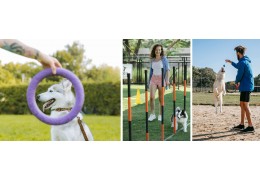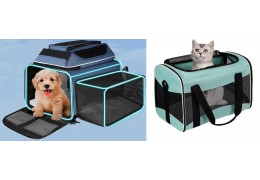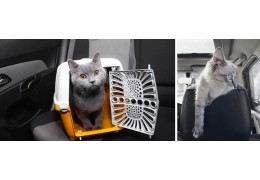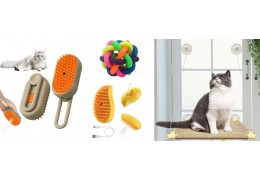Outdoor adventures with your pet can be exciting and rewarding, but proper training is essential for a safe and...
How to Choose the Right Leash and Harness for Outdoor Walks
Taking your dog for a walk is one of the most enjoyable activities for both you and your pet. Whether you prefer a dog leash, a dog tie out, or another type of leash of dog, selecting the right equipment is crucial for safety and comfort. With so many options available, choosing the best leash and harness for your furry friend can feel overwhelming. This guide will help you understand what to look for when selecting a leash and harness for outdoor walks.
1. Understanding Different Types of Dog Leashes
A dog leash is an essential tool for controlling your pet during walks, training sessions, and outdoor adventures. There are several types of leashes, each designed for specific needs:
Standard Dog Leash
This is the most common type of dog leash, typically made from nylon or leather. Standard leashes range from 4 to 8 feet in length, providing enough freedom for your dog while maintaining control.
Pros:
• Ideal for daily walks
• Easy to handle
• Durable and long-lasting
Cons:
• Limited range for dogs that enjoy more freedom
Retractable Leash
A retractable dog leash extends and retracts, giving your dog more freedom while allowing you to control the length as needed.
Pros:
• Provides flexibility
• Allows dogs to explore
• Adjustable length
Cons:
• Can be dangerous if not used properly
• Not suitable for dogs that pull excessively
Adjustable Leash
An adjustable dog leash is a versatile option that allows you to change its length. This type of leash is great for training and can be used in different environments.
Pros:
• Adjustable for different walking situations
• Suitable for training
Cons:
• May not be as sturdy as fixed-length leashes
Chain Leash
A chain dog leash is designed for dogs that tend to chew through nylon or leather leashes. While durable, it can be heavy for smaller dogs.
Pros:
• Chew-proof
• Long-lasting
Cons:
• Heavy
• Less comfortable to hold
2. Choosing the Right Dog Tie Out
A dog tie out is a great option for giving your dog some freedom while keeping them safe in an outdoor area.
Cable Tie Out
A cable dog tie out is made from strong, coated steel wire and is designed for securing your dog in one area without a fence.
Pros:
• Provides freedom while ensuring safety
• Ideal for large backyards or camping trips
• Durable and weather-resistant
Cons:
• Not ideal for all dogs, especially those prone to tangling
Spiral Stake Tie Out
A spiral stake dog tie out screws into the ground and attaches to a cable, providing a secure hold for your dog.
Pros:
• Easy to install
• Keeps dogs secure
• Affordable
Cons:
• Not suitable for very strong or large dogs
Trolley System Tie Out
This type of dog tie out allows your dog to move along a line rather than being confined to a single spot.
Pros:
• Allows more movement than a standard tie out
• Keeps dogs contained safely
Cons:
• Requires setup and space
• Can tangle if not properly installed
3. Selecting the Best Leash of Dog for Your Needs
When choosing a leash of dog, consider the following factors:
Material
• Nylon: Lightweight, affordable, and available in various colors.
• Leather: Durable, stylish, and comfortable to hold.
• Metal Chain: Ideal for dogs that chew their leashes.
Length
• Short leashes (4 feet or less): Provide better control, ideal for crowded areas.
• Medium-length leashes (5-6 feet): Great for general walking.
• Long leashes (8-30 feet): Used for training and outdoor activities.
Handle Comfort
A padded handle can make holding the leash of dog more comfortable, especially for longer walks.
Clip Type
The clip that attaches to your dog's collar should be strong and secure to prevent accidental releases.
4. Choosing the Right Harness
A harness is a great alternative to a collar, especially for dogs that pull or have respiratory issues.
Back-Clip Harness
This harness has a clip on the back, making it easy to use and comfortable for the dog.
Pros:
• Ideal for well-trained dogs
• Comfortable and easy to put on
Cons:
• Not suitable for dogs that pull
Front-Clip Harness
A front-clip harness helps discourage pulling by redirecting the dog's movement.
Pros:
• Helps with training
• Provides better control
Cons:
• May be harder to put on
Dual-Clip Harness
A dual-clip harness has both front and back attachment points, providing flexibility.
Pros:
• Versatile
• Great for training
Cons:
• More expensive than standard harnesses
5. Matching the Leash and Harness to Your Dog’s Behavior
Different dogs have different walking habits, and choosing the right combination of a dog leash, dog tie out, and leash of dog depends on their behavior.
• For Dogs That Pull: A front-clip harness paired with a strong, non-retractable dog leash can help control pulling.
• For Active Dogs: A long leash of dog or a dog tie out allows more movement while keeping them safe.
• For Small Dogs: A lightweight dog leash and soft harness provide comfort and security.
6. Safety Tips for Using a Dog Leash and Harness
• Check for Wear and Tear: Regularly inspect your dog leash and dog tie out for signs of damage.
• Proper Fit: A harness should be snug but not too tight.
• Use Reflective Gear: If walking at night, opt for a reflective leash of dog for visibility.
• Monitor Your Dog: Never leave your dog unsupervised while on a dog tie out.
7. Maintain a Calm Environment
A serene atmosphere helps keep your cat relaxed during the trip.
Temperature Control: Keep the car at a comfortable temperature, avoiding extreme heat or cold.
Noise Reduction: Minimize loud music and sudden noises. Speaking softly to your cat can be reassuring.
Cover the Carrier: If your cat is particularly anxious, covering the carrier with a light blanket can create a den-like, secure feeling.
8. Monitor Your Cat's Behavior
Being attentive to your cat's needs ensures their well-being.
Signs of Stress: Panting, excessive meowing, or restlessness may indicate discomfort. If these signs persist, consult a veterinarian.
Hydration and Feeding: Offer water regularly and maintain feeding routines as much as possible.
Litter Box Access: If on an extended trip, provide litter box breaks at safe and enclosed locations.
9. Prepare for Emergencies
Being prepared for unforeseen situations is essential.
Emergency Kit: Include basic first-aid supplies and any medications your cat may need.
Veterinary Contacts: Research veterinary clinics along your route and at your destination.
Pet Insurance: If you have pet insurance, keep a copy of your policy and emergency vet contacts handy.
10. Post-Trip Care
After reaching your destination, help your cat adjust to the new environment.
Safe Space: Set up a quiet area with familiar items where your cat can relax and acclimate.
Supervision: Initially, supervise your cat's exploration to ensure their safety.
Monitor for Stress or Illness: Look for signs of stress or health issues, such as hiding, refusal to eat, or excessive grooming. If any concerning symptoms arise, consult a veterinarian.
11. What to Do If Your Cat Becomes Anxious
If your cat shows signs of anxiety, here are some ways to help calm them:
• Play Soft Music: Classical or calming cat music can soothe an anxious feline.
• Offer Treats and Praise: Reinforce positive behaviors with treats and affection.
• Avoid Frequent Handling: Let your cat settle in the carrier without excessive petting or movement.
Conclusion
Choosing the right dog leash, dog tie out, and leash of dog ensures a safe and enjoyable outdoor experience for both you and your pet. By considering factors such as material, length, and fit, you can find the best option to suit your dog's needs. Whether you're looking for a standard leash, a retractable leash, or a reliable tie-out system, selecting the right equipment will make every walk more enjoyable. Always prioritize safety and comfort to ensure happy adventures with your furry companion!












